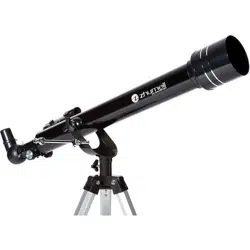Loading ...
Loading ...
Loading ...

7
OBJECTIVE
The objective is the front lens of a telescope. The listed measurement
for objective lenses is the lens diameter. A larger objective allows
more light to enter a telescope and provides a brighter image. The
objective diameter is also sometimes referred to as the aperture of
a telescope.
FOCAL LENGTH
The focal length of a telescope is the distance from the point where
light enters a telescope (the objective) to the point where the image
is in focus. In telescopes with the same size objective, a longer focal
length will provide higher magnication and a smaller eld of view.
MAGNIFICATION
The magnication of a telescope is determined by the relationship
between the focal length of the telescope and the focal length of the
eyepiece used. A greater dierence in these focal lengths results in
a greater the magnication of the telescope. Every telescope has
a maximum useful magnication of about 60 times the diameter of
the objective in inches. Magnication beyond the maximum useful
magnication will provide dim, low contrast images.
FOCAL RATIO
The focal ratio of a telescope is a description of the relationship
between the focal length and objective lens size of a telescope.
Visually, a smaller focal ratio (also called f-stop) provides a wider
eld of view. Photographically, the lower the f-stop, the shorter the
exposure time needed to capture an object on lm.
LIMITING MAGNITUDE
The limiting magnitude of a telescope describes the faintest object
you can see with a telescope. The magnitude of a star describes
its brightness. The larger the magnitude of an object, the fainter it
appears to be. The brightest stars have a magnitude of 0 or less.
RESOLVING POWER
The resolving power, or Dawes’ Limit, of a telescope is the ability
to view closely spaced objects through a telescope. The resolving
power of a telescope is measured in seconds of arc. The smaller the
resolving power, the better you will be able to separate binary stars
when viewing through your telescope.
ABERRATION
Aberrations are degradations in image, which can occur due to optical
system design or improper alignment of optical system components.
The most common types of aberration are chromatic aberration,
spherical aberration, coma, astigmatism, and eld curvature.
COLLIMATION
Collimation is the alignment of optical components within an optical
system. Improper collimation will distort an image and may result
in aberrations present in the image. Most reector telescopes have
collimation adjustments which can be made in order to reduce aberrations
and image distortion. Refractor telescopes do not require collimation
nearly as often as reector telescopes.
TELESCOPE
TERMINOLOGY
Loading ...
